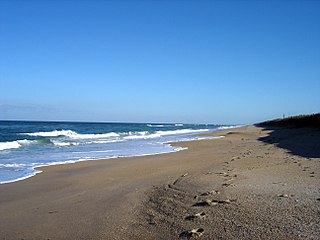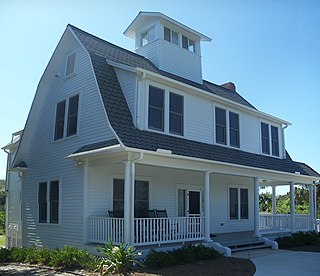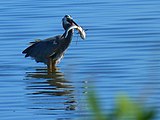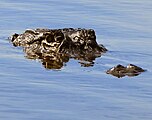Canaveral National Seashore: Difference between revisions
mNo edit summary |
m (→About) |
||
| Line 13: | Line 13: | ||
<br/>( 28°55'37.8"N 80°49'26.8"W ) | <br/>( 28°55'37.8"N 80°49'26.8"W ) | ||
</div> | </div> | ||
Canaveral National Seashore was created through congressional legislation on January 3, 1975 (by Public Law 93-626) to preserve and protect the natural, scenic, scientific, ecological, archeological, and historical values and resources within the national seashore, and to provide for public outdoor recreational use and enjoyment of those resources. | Canaveral National Seashore is an outdoor lover's paradise. Recreational activities include scenic drives, hiking, fishing, paddling, wildlife watching, and [[Canaveral National Seashore/Backcountry Camping|primitive camping]]. The national seashore's northern entrance is at Apollo Beach in Volusia County's New Symyrna. The southern entrance is at Playalinda Beach, due east of Titusville in Brevard County. Both visitor centers are usually open 9am-5pm. The park is usually open from 6am until dusk. Admission is $15 for automobiles and $10 for motorcycles. Visit the [https://www.nps.gov/cana/index.htm Canaveral National Seashore website] for current news and information. | ||
The Canaveral National Seashore was created through congressional legislation on January 3, 1975 (by Public Law 93-626) to preserve and protect the natural, scenic, scientific, ecological, archeological, and historical values and resources within the national seashore, and to provide for public outdoor recreational use and enjoyment of those resources. | |||
[[File:CanaveralNationalSeashore1.jpg|320px|thumb|right|Canaveral National Seashore]] | [[File:CanaveralNationalSeashore1.jpg|320px|thumb|right|Canaveral National Seashore]] | ||
The seashore's 24 miles of pristine, undeveloped beach represent an excellent example of a stable barrier beach island backed by a productive lagoon system. The seashore is comprised of a barrier island ecosytem and contains nearly 58,000 acres of bar-built barrier island, open lagoon, coastal hammock, pine flatwoods, and offshore waters. The seashore is prime habitat for many threatened and endangered species and provides nesting beaches for several thousand protected marine turtles. Canaveral's barrier island is the eastern boundary of Mosquito Lagoon. The lagoon encompasses more than two-thirds of the national seashore, and is designated an estuary of national significance. It is one of the most diverse and productive estuaries in North America.<ref>[https://www.nps.gov/cana/ Canaveral National Seashore NPS]</ref> | The seashore's 24 miles of pristine, undeveloped beach represent an excellent example of a stable barrier beach island backed by a productive lagoon system. The seashore is comprised of a barrier island ecosytem and contains nearly 58,000 acres of bar-built barrier island, open lagoon, coastal hammock, pine flatwoods, and offshore waters. The seashore is prime habitat for many threatened and endangered species and provides nesting beaches for several thousand protected marine turtles. Canaveral's barrier island is the eastern boundary of Mosquito Lagoon. The lagoon encompasses more than two-thirds of the national seashore, and is designated an estuary of national significance. It is one of the most diverse and productive estuaries in North America.<ref>[https://www.nps.gov/cana/ Canaveral National Seashore NPS]</ref> | ||
Canaveral National Seashore is managed by the National Park Service in partnership with the National Aeronautics and Space Administration (NASA). NASA owns approximately two-thirds of the national seashore, along with the adjacent U.S. Fish and Wildlife Service's Merritt Island National Wildlife Refuge. Vehicle traffic is often stopped during rocket launches, but the | Canaveral National Seashore is managed by the National Park Service in partnership with the National Aeronautics and Space Administration (NASA). NASA owns approximately two-thirds of the national seashore, along with the adjacent U.S. Fish and Wildlife Service's Merritt Island National Wildlife Refuge. Vehicle traffic is often stopped during rocket launches, but the park usually remains open to visitors, and provides an excellent, close-up launch viewing area. | ||
==History== | ==History== | ||
===Turtle Mound=== | ===Turtle Mound=== | ||
Revision as of 14:13, November 15, 2019
Twenty four mile Canaveral National Seashore is the longest remaining stretch of undeveloped beach on Florida's east coast.
About
7611 S Atlantic Ave, New Smyrna Beach, FL 32169
( 28°55'37.8"N 80°49'26.8"W )
Canaveral National Seashore is an outdoor lover's paradise. Recreational activities include scenic drives, hiking, fishing, paddling, wildlife watching, and primitive camping. The national seashore's northern entrance is at Apollo Beach in Volusia County's New Symyrna. The southern entrance is at Playalinda Beach, due east of Titusville in Brevard County. Both visitor centers are usually open 9am-5pm. The park is usually open from 6am until dusk. Admission is $15 for automobiles and $10 for motorcycles. Visit the Canaveral National Seashore website for current news and information.
The Canaveral National Seashore was created through congressional legislation on January 3, 1975 (by Public Law 93-626) to preserve and protect the natural, scenic, scientific, ecological, archeological, and historical values and resources within the national seashore, and to provide for public outdoor recreational use and enjoyment of those resources.
The seashore's 24 miles of pristine, undeveloped beach represent an excellent example of a stable barrier beach island backed by a productive lagoon system. The seashore is comprised of a barrier island ecosytem and contains nearly 58,000 acres of bar-built barrier island, open lagoon, coastal hammock, pine flatwoods, and offshore waters. The seashore is prime habitat for many threatened and endangered species and provides nesting beaches for several thousand protected marine turtles. Canaveral's barrier island is the eastern boundary of Mosquito Lagoon. The lagoon encompasses more than two-thirds of the national seashore, and is designated an estuary of national significance. It is one of the most diverse and productive estuaries in North America.[1]
Canaveral National Seashore is managed by the National Park Service in partnership with the National Aeronautics and Space Administration (NASA). NASA owns approximately two-thirds of the national seashore, along with the adjacent U.S. Fish and Wildlife Service's Merritt Island National Wildlife Refuge. Vehicle traffic is often stopped during rocket launches, but the park usually remains open to visitors, and provides an excellent, close-up launch viewing area.
History
Turtle Mound
Turtle Mound is a 50' tall shell midden made by the Timucuan Indians starting around 1200 AD. The mound was built from oyster shells discarded by the Timucuans as they consumed the Mosquito Lagoon's bountiful oyster bars. While most shell middens on Florida's east coast were destroyed and used for land fill on road projects, Turtle Mound, along with Canaveral National Seashore, was purchased in 1924 by The Florida State Historical Society for $8,000.[2] Today, Turtle Mound is an active archeological dig.
Historic Eldora House
Eldora was a prominent community of orange groves in the latter part of the 19th century. After a freeze destroyed most of its crops, it was almost abandoned and has never regained its population. After the death of its last resident, Doris "Doc" Leeper in 2000, a locally famous artist and conservationist in the 1980s, the management of the town was officially turned over to the federal government, and the town is now located more than two miles within the borders of the Canaveral National Seashore.
The town claims no permanent residents, and visitation is limited and subject to park hours. Only two of its original buildings remain. The largest, "The Eldora House", now holds a museum. Although the town's orange groves were nearly completely wiped out over one hundred years ago, some trees still remain.The town is now the site of two marine research facilities jointly shared by Daytona State College and the University of Central Florida.
Video
Aerial video shot before Cana outlawed drones.
You Tube: Canaveral National Seashore, Apollo Beach
Quick tour of the Apollo Beach area of Canaveral National Seashore. Hiking, cycling, kayaking.
YouTube: Canaveral National Seashore, Playalinda Beach
Canaveral National Seashore and Playalinda Beach at the Merritt Island National Wildlife Refuge along the north east edge of Kennedy Space Center and Cape Canaveral Air Force Station in Brevard and Volusia counties, Florida.









